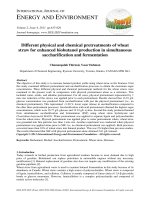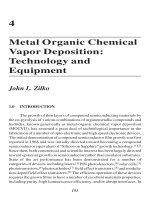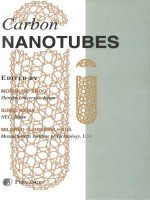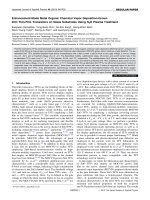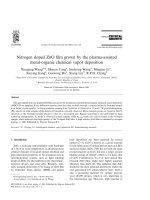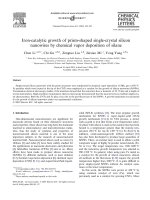- Trang chủ >>
- Khoa Học Tự Nhiên >>
- Vật lý
plasma - enhanced chemical vapor deposition carbon nanotubes for ethanol gas sensors
Bạn đang xem bản rút gọn của tài liệu. Xem và tải ngay bản đầy đủ của tài liệu tại đây (1.46 MB, 6 trang )
Plasma-enhanced chemical vapor deposition carbon nanotubes for ethanol gas sensors
Chia-Te Hu
a
, Chun-Kuo Liu
a
, Meng-Wen Huang
b
, Sen-Hong Syue
a
, Jyh-Ming Wu
c
, Yee-shyi Chang
a
,
Jien-W. Yeh
a
, Han-C. Shih
a,d,
⁎
a
Department of Materials Science and Engineering, National Tsing Hua University Hsinchu, 30013, Taiwan, ROC
b
Department of Materials Science and Engineering, National Chung Hsing University Taichung, 40227, Taiwan, ROC
c
Materials Science and Engineering, Feng Chia University Taichung, 40724, Taiwan, ROC
d
Institute of Materials Science and Nanotechnology, Chinese Culture University Taipei, 11114, Taiwan, ROC
abstractarticle info
Available online 12 November 2008
Keywords:
Carbon nanotubes
Ethanol
Conductance
Gas sensor
Adsorption
Surface modification
Carbon nanotubes (CNTs) have been fabricated by microwave plasma-enhanced chemical vapor deposition
for detecting the presence of ethanol vapor. The conductance of the CNTs decreases when the sensors are
successively exposed to ethanol vapor at room temperature. The surface of the CNTs was modified in oxygen
plasma to elevate the detection sensitivity for ethanol. Successful utilization of CNTs in gas sensors may open
a new window for the development of novel nanostructure gas devices.
© 2008 Elsevier B.V. All rights reserved.
1. Introduction
The remarkable structural, electrical, mechanical, and chemical
properties of carbon nanotubes (CNTs) have generated great interest
in various fields [1–5]. Of special interest is the gas adsorption
property that allows CNTs to be made as new gas materials, depending
on their large surface area [6–8] and hollow geometry. Several models
that account for the gas sensor applications of CNTs have been
reported recently [9–16]. Hyeok et al. [17] fabricated a gas sensor from
a nanocomposite by polymerizing pyrrole monomers with single wall
carbon nanotubes (SWCNTs). Polypyrrole (Ppy) was prepared by a
simple and straightforward in-situ chemical polymerization of pyrrole
mixed with SWCNTs, and the sensor electrodes were formed by spin-
casting SWCNT/Ppy onto pre-patterned electrodes. They found that
the sensitivity of the nanocomposite was about ten times higher than
that of Ppy. The SWCNT bundles could be nanodispersed, which may
increase the specific surface area of the coated Ppy and thereby further
increase the sensitivity. One of the most difficult aspects of CNT gas
sensing is that most techniques are based on SWCNT field-effect
transistors or require UV light irradiation to desorb the detected gas
molecules. Furthermore, multiwall carbon nanotubes (MWCNTs) are
not very sensitive to ambient gases [12–15]. Our objective in this
investigation is to modify the surface of MWCNTs for elevating the
detection sensitivity of an ethanol gas sensor. It is therefore necessary
to upgrade the surface structure of MWCNTs precisely in order to
realize the applications of the devices. However, only a few papers have
investigated the use of MWCNTs for ethanol detection. Liang et al. [16]
reported a resistance sensor fabricated from MWCNTs coated with a
thin tin-oxide layer and found that the barrier height between the tin-
oxide grains on the MWCNTs varies for different gases so that the
sensor resistance changes markedly, which makes the sensitivity of the
sensors great enough for real applications. In addition, the Shottky
barrier between tin-oxide grains and MWCNTs is very low, such that
electrons conduct in the MWCNTs with low resistance.
So far, only noise studies on gas sensors at elevated temperatures
have been carried out. Wan et al. [18] fabricated a gas sensor from a
ZnO oxide nanowire; its sensitivity at an ethanol concentration of
100 ppm increased sharply as the temperature increased from 200 to
300 °C, mainly due to the enhanced reaction between the ethanol and
the absorbed oxygen at an elevated temperature. This model,
however, cannot be applied under room temperature conditions.
Therefore, a more generalized model is required. In this paper, we
present the results of ethanol gas detection by MWCNTs at room
temperature and use a distinct oxygen plasma treatment to enhance
the sensitivity. It was found experimentally that the sensitivity of
MWCNT gas sensors varies significantly with various gas concentra-
tions at room temperature after oxygen plasma modification. In order
to perform our study, the structure was systematically analyzed by
field emission scanning electron microscopy (FE-SEM), and further
quantitative analysis was conducted by high-resolution transmission
electron microscopy (HRTEM). In the sensor structure, MWCNT
growth occurred on an aluminum oxide substrate that was strongly
held by two alligator clamps acting as electrodes for the conducting
current. This assembly is highly sensitive to the presence of the
Diamond & Related Materials 18 (2009) 472–477
⁎ Corresponding author. Department of Materials Science and Engineering, National
Tsing Hua University Hsinchu, 30013, Taiwan, ROC. Tel.: +886 3 5715131x33845;
fax: +886 3 5710290.
E-mail address: (H C. Shih).
0925-9635/$ – see front matter © 2008 Elsevier B.V. All rights reserved.
doi:10.1016/j.diamond.2008.10.057
Contents lists available at ScienceDirect
Diamond & Related Materials
journal homepage: www.elsevier.com/locate/diamond
ethanol molecules. The conductance of the sensors adjusts itself when
they are exposed to ethanol gas.
2. Experimental
In this work, microwave plasma enhanced chemical vapor
deposition (MPECVD) was used to synthesize the carbon nanotubes.
An iron-containing compound was used as the catalyst, which was
first coated onto a non-conductive aluminum oxide substrate using a
sol-gel method to promote the growth of carbon nanotubes. The
substrate was placed in the MPECVD chamber, where a mixture gas of
methane and hydrogen (1:10) was introduced and simultaneously
decomposed by the microwaves to synthesize carbon-related materi-
als. During this period, the pressure was kept at 20 Torr with a
microwave power of 1.5 kW at 650 °C as measured by a thermocouple
(CA). After the growth of the CNTs, the microwave chamber was
cooled down to room temperature, and surface modification treat-
ment was subsequently started. The oxygen plasma treatments for the
MWCNTs were conducted under the following conditions: oxygen
flow rate of 20 sccm, operating pressure of 0.5 Torr, microwave power
of 600 W, process duration of 5–35 s, and average sample temperature
of about 30 °C. It was demonstrated that the treatment result was
Fig. 1. FE-SEM images of CNTs treated in oxygen plasma at a microwave power of 600 W for (a) 0 s; showing the amorphous carbon clamped on the surface of CNTs, (b) 5 s, (c) 20 s,
(d) 35 s, (e) 60 s, and (f) 90 s.
Fig. 2. HRTEM images of CNTs treated in oxygen plasma for (a) 0 s; denoting the amorphous carbon clamped on the surface of CNTs, (b) 20 s; showing the removal of the amorphous
carbon, and (c) 35 s; CNTs becoming loosely attached, accounting for the ion sweeping over the CNTs.
473C T. Hu et al. / Diamond & Related Materials 18 (2009) 472–477
directly related to the excited species density, which was controlled by
the treatment duration. The morphology of the specimens was
examined by field emission scanning electron microscopy (FE-SEM,
JSM-6500F). High-resolution electron microscopy (HRTEM, JEOL JEM-
2010) was performed at 200 kV with a point resolution of 0.19 nm and
a lattice resolution of 0.1 nm.
Adsorption isotherm experiments were performed at − 261.17 °C
with a Micromeritics ASAP 2000 accelerated surface and porosimetry
analysis system using N
2
gases on the MWCNT samples with masses of
∼ 0.2 g. Before each adsorption isotherm test, the nanotube bundles
were exposed to a high vacuum for at least 3 h at 120 °C and b 10
− 6
Torr
to ensure complete desorption of adsorbates. All measurements were
conducted at − 261.17 °C; the saturation pressure p
0
for N
2
at this
temperature is 760 Torr. Gas-sensing experiments were carried out
using a volt-amperometric technique. During the experiment, the
MWCNT-based gas sensor was placed in a sealed chamber with an
electrical feedthrough. Pure ethanol gas flowed through the sealed
chamber while the e lectrical properties of the MWCNTs were
monitored. All such measurements were taken at 25 °C.
3. Results and discussion
Fig. 1 shows the surface morphology of the CNTS with various
modification durations from the SEM analysis. Clearly visible in Fig.1(a)
are the amorphous carbon layers deposited on the surface, connecting
with each other, which probably result from incomplete carbon atomic
piling. When CNTs were treated for 5 and 20 s, the amorphous carbon
domains are eliminated, and the tubes become smoother and cleaner as
shown in Fig.1(b) and (c). After 60 and 90 s, as seen in Fig.1 (e) an d (f), the
carbon nanotubes become ambiguous and one can not distinguish a
single carbon nanotube from the rest. From the results, it can be seen
that the oxygen plasma treatment can remove the fragile parts like
amorphous carbon, but too much treatment would eventually destroy
the CNTs.
High-resolution transmission electron microscopy (HRTEM) played
a vital role, as it is the only technique that allows for real space imaging
of atomic distribution in nanoparticles, particularly when the particle
size is small. With consideration of the particle shape symmetry,
HRTEM can be used to determine the 3D shape of small particles
although the image is a 2D projection of a 3D object. The grown carbon
nanotubes for TEM analysis were separated from the substrate and
then ultrasonicated in ethanol. After ultrasonic treatment, a drop of
liquid was then sprayed onto a carbon-coated copper grid. The CNTs
were analyzed by TEM to confirm that they were really CNTs and not
carbon fibers. Fig. 2 reveals that the CNTs have an inner diameter of
∼ 8 nm, an outer diameter of ∼ 23 nm, and the distance between wall
layers is ∼ 0.33 nm. Comparison of the images in Fig. 2(a) and (b)
indicates that the oxygen plasma modification exerted to the surface of
the CNTs can remove impurities as well as amorphous carbons. This is
due to the fact that the amorphous carbons are easily oxidized under
the oxygen plasma species. Unfortunately, we were not able to obtain
the microstructure when we continuously applied the oxygen
plasma treatment for a duration longer than 20 s, as shown in
Fig. 2(c). This is because ion bombardments may cause the creation
of vacancies and i nterstitials in the MWCN Ts. The surface s tructure,
including defects and amorphous carbons on the carbon nan owires,
is removed due to the ion sweeping, which leads to an incre ase in
diameter. The results from TEM in combinatio n with SEM figures
reveal that the surface of the CNTs can be indeed modified by oxygen
plasma treatment, but p rolonged treatments are harmful and can
destroy the outside walls.
Using the Br unauer–Emmett–Teller ( BET) method, t he adsorp tion
isotherms of N
2
ontheMWCNTsweremeasuredforallthesamples
Fig. 3. Adsorption and desorption isotherms of N
2
on modified MWCNTs at − 261.17 °C;
the saturation pressure p
0
for N
2
is 760 Torr for (a) 0 s, (b) 5 s, (c) 20 s, and (d) 35 s.
474 C T. Hu et al. / Diamond & Related Materials 18 (2009) 472–477
at − 261.17 °C. Results sho wed that all of the adsorption iso therms
(at − 261.17°C)fortheMWCNTsareclosetoTypeIV[1 9–20], i.e .,
having h yster esis loops. The relative pressure p/p
o
is moder atel y high
Fig. 5. Three cycles of response-recovery characteristics of the MWCNTs exposed to
various ethanol concentrations for distinct modification for (a) 0 s, (b) 5 s, (c) 20 s, and
(d) 35 s.
Table 1
Adsorption properties of N
2
on MWCNTs, obtained by the BET method
Oxygen
plasma
treating
time (s)
Specific surface
area: A
s
(m
2
/g)
Monolayer
adsorption
capacity:
V
m
(cc/g STP)
Single point
surface area at
p/p
o
0.1984 (m
2
/g)
Micropore area
(m
2
/g)
0 91.3 21.0 90.0 14.5
5 97.0 22.2 95.0 15.2
20 102.5 24.0 100.7 16.4
35 90.1 20.0 88.3 14.3
Fig. 4. Adsorption isotherm curves for various modified CNTs at (a) low relative
pressure, (b) medium relative pressure, and (c) high relative pressure.
475C T. Hu et al. / Diamond & Related Materials 18 (2009) 472–477
when p/p
o
≈ 0.06–0.7 3, and t he amount a dsorbed incr eases steeply after
p/p
o
≈ 0.73, as sho wn in Fig. 3. Moreover, the overall enlarged adsorption
isotherms can be divided into three parts, A, B, and C, as shown in Fig. 4,
which indic ates that the capabilities of the CNTs t o absorb gases under
various oxygen plasma treatments follo w the order: 20 sN 5sN 0sN 35 s.
This curve is in qualitative agreement with the SEM and TEM observations
for the same result. As the duration of the modification increases, the gas
adsorption property enhances. Unfortunately , the gas volume adsorption
drops dr amatically for pr olonged e xposur e in oxygen plasma. This effect
might be due to the defects and amorphous carbons, which decrease the
gas adsorption capability. Applying the BET method to the data in Fig. 3
yields the monolayer adsorption capacity (V
m
)andthespecificsurface
area of adsorption ( A
s
), where molecular cross-sectional ar eas of 91.3, 97.0,
102.5, and 90. 1 m
2
/g wer e use d for N
2
duringtherespectivedurationof
oxy gen plasma modification, i.e., 0, 5, 20, and 35 s . Table 1 summarizes the
resulting V
m
and A
s
values of the MWCNT s.
Fig. 5 gives the electrica l property curves of th e MWCNT-based
sensors in a sealed chamber, which were evacuated to 10
− 5
Torr by a
turbo pump. We plot a typical time evolution of the conductance at a
temperature of 25 °C for a MWCNT-based sensor successively exposed to
10 ppm, 20 ppm, and 30 ppm etha nol gas. Th e do tted line represents the
variation of ethan ol concentr ation, which cor responds t o the dr oppi ng
time. It can be seen that as ethanol gas with a concentration of 10 ppm
was introduced for 60 s, the conductance of the gas sensor decreases
from its origina l electrical potential to the electrical potential due to
adsorption. As the ethanol gas was removed, conductance of the gas
sensor was lost. Similar behavior occurred at other concentrations of
ethanol gas (20 ppm and 30 ppm). The sensing mechanism is surface
conduction modulated by adsorbed gas molecules; the electrical
conductivity depends strongl y on surface states pr oduced by molecular
adsorption, which result in space-charge layer changes and band
modulation. In our new sensors based on carbon nanotubes, a large
fraction of theatoms are present at the surface and the surface properties
become paramount. Oxygen is known to have good charge transfer to
planar defected graphite, especially in the presence of catalytic metallic
particles. Carbon nanotubes can become hole-doped in the presence of
adsorbed oxygen after oxygen plasma treatment because of the electron
affinity of oxy gen [21]. Owin g to the interestin g lay er ed structure,
especially with ethanol intercalated, it reacts with C–Olayersthrough
hydrogen bonds to charge the conductivity of the sensors and causes the
current to decrease, as sh o wn in Fig. 6(a). Furthermore, the sen sitivity
was highest for the specimen treated for 20 s with oxygen plasma. In
order to realize the sensitivity of various surface modification durations,
the sens iti vity (S) can be calculated by S=C
air
/C
gas
,whereC
air
is the
conductivity of the surrounding air, and C
gas
is the c onductivity when
ethanol is i ntr oduced. Fig. 6(b)–(d) illus tr at es the sensitivity of various
surface modification durations. As we can see, the sensitivity of the
specimen with 20 s of oxygen plasma treatment is superior to that of the
other specimens, which were treated for other time durations. The
enhanced sensitivity may arise from the promoted surface-to-volume
ratio of CNTs and eliminate the unsteady performance of non-treated
CNTs (Fig. 5(a)). Moreover, once the ethanol is introduced, the
conductivity signal drops dramatically after the modification. It might
be that the defects and amorphous carbons decrease the gas adsorption
activation and that oxygen plasma treatment will however overcome
this disadvantage. But we are able to decrease the sensitivity if too much
oxy g en plasma treatment i s applied.
4. Conclusions
The MW CNT-bas ed gas sen sors made b y MPECVD fo r de tectin g
ethanol molecules ha ve been studied at a pp m-lev el at room temperature.
The conductance of the sensors decreases when the sensors are exposed
to ethanol gas. Development of the oxygen plasma modification li es at the
heart of success in enhancing the sensitivity . It is expected that this
technique will come into use as its utilization is more widely appreciated.
These s tudies hav e so far p ro ven t hat CNTs c an detect ethanol gas
remarkably, and further experiments on gas sensor devices still remain to
be conducted.
Acknowledgment
The authors would like to thank the National Science Council of the
Republic of China for support of this research under contract NSC95-
2221-E-034-020-MY2.
References
[1] Y.H. Yang, C.Y. Wang, U.S. Chen, W.J. Hsieh, Y.S. Chang, H.C. Shih, J. Phys. Chem. C
111 (2007) 1601–1604.
[2] S.H. Syue, S.Y. Lu, W.K. Hsu, H. C. Shih, Appl. Phys. Lett. 89 (2006) 163115.
Fig. 6. (a) In air , negatively charg ed oxyg en adsorbates cover the surface of the CNT s and make
the CNTs become hole-doped because of oxygen's electron affinity. In ethanol gas, oxygen
adsorbates react with the adsorbed ethanol molecules a ttached by h ydrogen bonds, trap
electrons, and cause the c urrent to decr ease. (b) Ch a nges i n s e nsiti vityas a function o f M W CNT
expo sure t o v arious eth anol concen trat ions for the modification. (c) Sensitivity for 0 s and 35 s.
476 C T. Hu et al. / Diamond & Related Materials 18 (2009) 472–477
[3] S.H. Tsai, C.T. Shiu, S.H. Lai, H.C. Shih, Carbon 40 (2002) 1597–1617.
[4] L.H. Chan, K.H. Hong, S.H. Lai, X.W. Liu, H.C. Shih, Thin Solid Film 423 (2002) 27–32.
[5] C.H. Wang, H.Y. Du, Y.T. Tsai, C.P. Chen, C.J. Huang, L.C. Chen, K.H. Chen, H.C. Shih,
J. Power Sources 171 (2007) 55–62.
[6] Ray H. Baughman, Changxing Cui, Anvar A. Zakhidov, Zafar Iqbal, Joseph N. Barisci,
Geoff M. Spinks, Gordon G. Wallace, Alberto Mazzoldi, Danilo De Rossi, Andrew G.
Rinzler , Oli ver Jaschinski, S iegmar R ot h, Miklos K ert esz, Science 284 (1999) 1340–1344.
[7] Chunming Niu, Enid K. Sichel, Robert Hoch, David Moy, Howard Tennent, Appl.
Phys. Lett. 70 (1997) 1480–1482.
[8] Philippe Serp, Massimiliano Corrias, Philippe Kalck, Appl. Catal. A: Gen. 253 (2003)
337–358.
[9] P.F. Qi, O. Vermesh, M. Grecu, A. Javey, Q. Wang, H.J. Dai, S. Peng, K.J. Cho, Nano Lett.
3 (2003) 347.
[10] J. Li, Y.J. Lu, Q. Ye, M. Cinke, J. Han, M. Meyyappan, Nano Lett. 3 (2003) 929.
[11] J.P. Novak, E.S. Snow, E.J. Houser, D. Park, J.L. Stepnowski, R.A. McGill, Appl. Phys.
Lett. 83 (2003) 4026.
[12] O.K. Varghese, P.D. Kichambre, D. Gong, K.G. Ong, E.C. Dickey, C.A. Grimes, Sens.
Actuators,B 81 (2001) 32.
[13] A. Modi, N. Koratkar, E. Lass, B.Q. Wei, P.M. Ajayan, Nature (London) 424 (2003) 171.
[14] L. Valentini, L. Lozzi, C. Cantalini, I. Armentano, J.M. Kenny, L. Ottaviano, S. Santucci,
Thin Solid Films 436 (2003) 95.
[15] Y.M. Wong, W.P. Kang, J.L. Davidson, A. Wisitsora-at, K.L. Soh, Sens. Actuators, B
93 (2003) 327.
[16] Y.X. Liang, Y.J. Chen, T.H. Wang, Appl. Phys. Lett. 85 (2004) 4.
[17] K.H. An, S.Y. Jeong, H.R. Hwang, Y.H. Lee, Adv. Mate. 16 (2004) 12.
[18] Q. Wan, Q.H. Li, Y.J. Chen, T.H. Wang, Appl. Phys. Lett. 84 (2004) 18.
[19] C.M. Yang, K. Kaneko, M. Yudasaka, S. Iijima, Physica B 323 (2002) 140.
[20] E. Frackowiaka, K. Metenier, V. Bertagna, F. Beguinb, Appl. Phys. Lett. 77 (2000)
2421–2423.
[21] Philip G. Collins, Keith Bradley, Masa Ishigami, A. Zettl, Science 287 (2000) 1801.
477C T. Hu et al. / Diamond & Related Materials 18 (2009) 472–477
